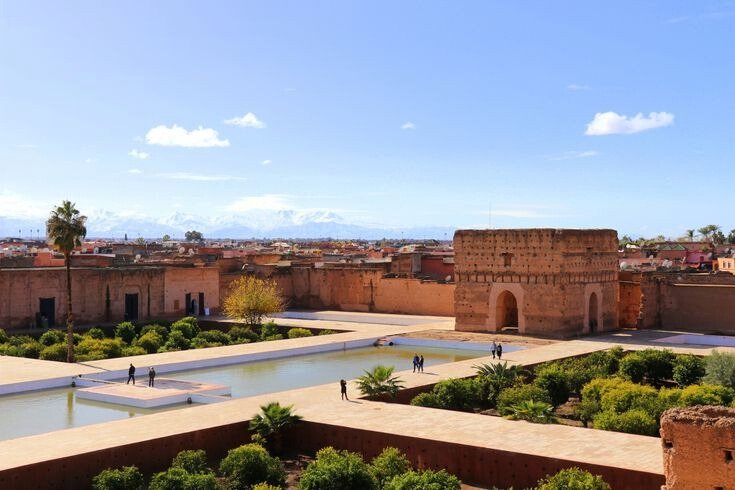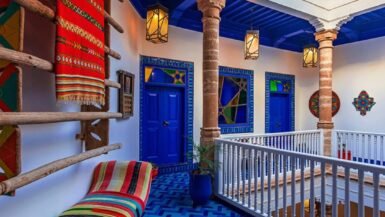Marrakech, the Red City, is known for its unique charm and the diversity of tourist attractions it offers to its visitors. Historical and religious monuments form an essential part of this charm, but Marrakech also hosts lush gardens and vibrant markets worth exploring. In this comprehensive guide, we will take you on a tour to discover the most prominent historical and religious landmarks and other outstanding tourist places to visit in Marrakech, such as Jemaa el-Fna Square, Bahia Palace, Ben Youssef Madrasa, Majorelle Gardens, Marrakech Souk, and others.
Table of Contents
Historical Landmarks and Ancient Palaces of Marrakech
Marrakech’s palaces, madrasas, and historical walls tell chapters of the city’s rich history, offering wonderful examples of traditional Moroccan architecture and authentic Islamic art.
Bahia Palace (Palais Bahia)
Bahia Palace is an architectural masterpiece built in the late 19th century by Vizier Ahmed ben Moussa. The palace is distinguished by its unique design that combines elegance and high artistic precision, with its open courtyards and beautiful interior gardens. During your visit, you will be amazed by the meticulous woodcarvings, colorful Moroccan zellige tilework, and ceilings adorned with carved stucco.
Practical information: The palace is located in the Riad district in the old medina, open from 9 AM to 5 PM, with reasonable entrance fees between 10-70 Moroccan dirhams. For more information about visiting Moroccan palaces, you can check the official Moroccan tourism website.
El Badi Palace (Palais El Badi)
El Badi Palace, or “The Incomparable Palace” as it is also known, was built in the 16th century by the Saadian Sultan Ahmed Al-Mansour Eddahbi. Although the palace is now in ruins, it still testifies to the grandeur of Saadian architecture. Its remains are characterized by huge water basins, sunken gardens, and towering walls, as well as storks that often build their nests on the palace walls, adding a living touch to this historical monument.
Practical information: The palace is located near the medina, open from 9 AM to 5 PM, with entrance fees between 10-60 Moroccan dirhams.
Ben Youssef Madrasa (Médersa Ben Youssef)
Ben Youssef Madrasa is one of the oldest Islamic schools in Morocco, rebuilt in the 16th century and functioning as an institute for Islamic studies. This madrasa is a remarkable example of Marinid and Saadian architecture, with its central courtyard decorated with zellige tilework and Arabic calligraphy, small student rooms arranged around the courtyard, and the prayer hall adorned with delicate plaster carvings.
Practical information: The madrasa is located near the Ben Youssef Mosque and the souks, open to visitors from 9 AM to 6 PM, with entrance fees of about 20-60 Moroccan dirhams.
The Historical Walls and City Gates (Remparts et Portes de la Ville)
The historical walls surround the old medina of Marrakech, and their construction dates back mainly to the Almoravid and Almohad eras. These ochre-red clay walls extend for more than 19 kilometers and include several important historical gates, notably:
- Bab Agnaou: One of the most beautiful gates of Marrakech, characterized by its geometric patterns and Kufic script.
- Bab Doukkala: A main gate that connected the city to the Doukkala route.
- Bab Aghmat: Named after the ancient city of Aghmat.
Practical information: The walls and gates can be explored during a walking tour around the old medina, and access for exterior viewing is free.
Jemaa el-Fna Square: The Beating Heart of Marrakech
Jemaa el-Fna Square is not just a square, but an open-air theater for Marrakech’s history, culture, and daily life, and a UNESCO World Heritage site since 2001. This famous square is a meeting point for locals and tourists from around the world.
The Atmosphere of Jemaa el-Fna Square: Day Magic and Night Rhythm
Jemaa el-Fna Square transforms from day to night in a unique theatrical scene. During the day, you will find snake charmers, magicians, storytellers, and juice vendors. As night falls, the square transforms into an open food market with dozens of stalls offering traditional Moroccan dishes, while the crowd grows denser around circles of musicians and dancers.
The Cultural and Historical Importance of the Square
Jemaa el-Fna Square reflects Marrakech’s historical role as a crossroads for trade caravans and a center for cultural exchange. The square is a living museum of Moroccan folk arts, where traditions and cultural practices continue through generations in a renewed daily spectacle.
Practical information: To enjoy a panoramic view of the square, you can visit one of the cafes or restaurants with terraces overlooking it, especially at sunset to observe the transformation of the square from day to night.
Religious Monuments and Sufi Zawiyas of Marrakech
Marrakech houses many religious monuments that reflect its spiritual importance, from grand mosques to historic Sufi zawiyas, making it an important destination for religious and cultural tourism.
Sufi Zawiyas and Their Spiritual Importance
Sufi zawiyas are religious and spiritual centers, often housing the tombs of prominent religious figures. These zawiyas play an important role in the spiritual life of Moroccans, being considered places for religious education, meditation, and religious celebrations. Among the important zawiyas in Marrakech are the Qadiriya Zawiya linked to the Qadiriya Sufi brotherhood, and the zawiya of Sidi Bel Abbès – one of the famous “Seven Saints” of Marrakech.
Important practical note: Please note that entry to zawiyas is often restricted to Muslims, and visitors are advised to respect the sacred nature of these places and comply with visitation rules.
The Koutoubia Mosque (Mosquée Koutoubia)
The Koutoubia Mosque is one of the most famous religious monuments in Marrakech and its largest mosque. It is distinguished by its imposing minaret, an architectural masterpiece from the Almohad era and an icon of the city. The minaret rises to 77 meters and is visible from most parts of the city.
Practical note: Entry to the mosque is not allowed for non-Muslims, but everyone can admire the exterior architecture and walk in the surrounding gardens.
The Gardens of Marrakech: Oases of Tranquility and Beauty
Away from the hustle and bustle of the city, Marrakech’s gardens offer a peaceful refuge and beautiful green spaces that reflect the diversity of cultures and artistic influences that have marked the city throughout its history.
Majorelle Garden (Jardins Majorelle)
Majorelle Garden is more of an artwork than a traditional garden, designed by French painter Jacques Majorelle in the 1920s, then purchased later by fashion designer Yves Saint Laurent. The garden is characterized by the distinctive Majorelle blue of buildings and basins, and houses a unique collection of succulent and tropical plants, as well as the Berber Museum located in the original Majorelle villa.
Practical information: The garden is located outside the medina in the modern city of Gueliz, open from 8 AM to 6 PM, with separate entrance fees for the garden and museum. It’s a busy tourist destination, so it’s advisable to visit early. You can get additional information about Marrakech gardens from the Lonely Planet guide.
Menara Gardens (Jardins de la Ménara)
Menara Gardens are historic gardens dating back to the Almohad era in the 12th century. They are characterized by a vast water basin and an elegant pavilion that reflects its image on the water’s surface, surrounded by extensive olive groves. These gardens served as a water reservoir and a historic agricultural area.
Practical information: The gardens are located southwest of the medina, entry is generally free for walking among the olive trees, with the possibility of taking beautiful photos of the pavilion with the Atlas Mountains in the background.
The Marrakech Souk: A World of Traditional Commerce
The Marrakech souk is one of the largest and most famous traditional markets in Morocco, a true labyrinth of crafts, goods, and unique atmospheres that reflect the culture and history of the city.
Location and Layout of the Souk
The Marrakech souk is located just north of Jemaa el-Fna Square, forming a vast, complex network of covered alleys that extend for kilometers. Different sections of the souk specialize in specific goods, making it easier for visitors to find what they are looking for, whether it’s the leather market, carpets, or jewelry.
What to Buy at the Marrakech Souk
The goods in the Marrakech souk are highly varied, and among the most notable traditional products you can buy:
- Leather goods: bags, shoes, wallets with traditional designs
- Textiles: carpets, kilims, blankets, and curtains
- Pottery and ceramics: plates, utensils, colorful art objects
- Metal objects: lanterns, chandeliers, copper utensils
- Spices and herbs: a wide range with distinctive flavors and authentic Moroccan cooking ingredients
- Traditional clothing: djellabas, caftans, shawls
- Jewelry: silver and gold with Amazigh and Arabic designs
Shopping Atmosphere and Bargaining
Shopping in the Marrakech souk is a complete sensory experience; a mix of colors, smells, and sounds. Interaction with vendors and bargaining are an essential part of the experience, as initial prices are often exaggerated. To bargain successfully, start by offering about 30-40% of the asking price, and negotiate politely until reaching a price suitable for both parties.
Practical Information for Visiting the Main Monuments and Tourist Sites of Marrakech
To make your visit to this diverse collection of historical and religious monuments and tourist sites in Marrakech enjoyable and smooth, here are some general tips:
Getting Around the City
- In the medina: Walking is the best option, but beware of motorcycles and bicycles.
- Small taxis: Suitable for moving around the city at reasonable prices.
- Horse-drawn carriages: A pleasant traditional means to tour the city.
Best Time to Visit
- Seasons: Spring and autumn offer moderate weather ideal for exploration.
- Times of day: Early morning to avoid crowds at tourist sites, and evening to experience Jemaa el-Fna Square in its unique atmosphere.
Visitation Etiquette
- Modest dress: Especially when visiting religious sites, it’s preferable to cover shoulders and knees.
- Photography: Ask permission before photographing people, especially in traditional places.
- Bargaining: Negotiate gently and respectfully in the souks, and consider it part of the cultural experience.
Tickets and Fees
Most major historical sites and gardens require entrance fees, while squares (like Jemaa el-Fna) and strolling in the souks are free. It is advisable to check current prices before visiting.
Tour Guides
You can hire a licensed local tour guide, especially for navigating the medina and souks or to get more detailed historical information.
Accommodation in Marrakech
Marrakech offers a variety of accommodation in Marrakech options ranging from traditional riads to modern hotels, suitable for all budgets and ensuring a comfortable stay near tourist attractions.
Other Destinations in Morocco
Visitors can also explore other Moroccan cities like Rabat the capital and Fes the historic city, which offer remarkable historical and cultural monuments that complement the travel experience in Morocco.
Conclusion: Exploring the Historical, Religious, and Cultural Treasures of Marrakech
Marrakech offers a unique and rich tourist experience through the mix of its historical and religious monuments and diverse tourist sites. From its ancient palaces like Bahia and El Badi, to the lively Jemaa el-Fna Square, from Sufi zawiyas that reflect the depth of spiritual heritage, to the beautiful Majorelle and Menara gardens, to its lively traditional markets – all these places allow visitors to discover the true soul of the Red City.
We hope this guide will help you plan your visit to the main historical and religious monuments and tourist sites of Marrakech, and we invite you to share your own experiences and advice with other travelers interested in discovering the treasures of this fascinating Moroccan city. For more tips and useful information, you can visit the Moroccan National Tourist Office or the TripAdvisor guide to read reviews from other travelers.






Leave a reply